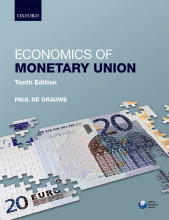The transition to a monetary union
6 important questions on The transition to a monetary union
On which two principles was the Maastricht Treaty based?
2. entry into the union was made conditional on satisfying convergence criteria
What were the convergence criteria?
2. its long term interest rate is not more than 2% higher than the average observed in these 3
3. it has joined the exchange rate mechanism of the EMS and no devaluation in the past 2 years
4. budget deficit not higher than 3% of GDP (or decreasing to it)
5. debt should not exceed 60% of GDP (or approach it)
Where do the 3% deficit and 60% debt ratios come from?
In order to stabilize debt at 60%, the budget deficit must be 3%, if the growth rate is 5% (0.03 = 0.05 x 0.6)
arbitrary: why 60%? > This was average debt at the time.
Countries with higher growth rates can have higher budget deficits
- Higher grades + faster learning
- Never study anything twice
- 100% sure, 100% understanding
Why must interest rates converge?
Suppose the UK wants to join, with a long-term bond rate of 5%. The long-term bond rates in euros is 3%. Bondholders want to sell low yield euro denominated bonds and buy high yield pound bonds. Since exchange rate is fixed (no exchange rate risk) this will continue until the return on euro and pound bonds are equal. Economic agents holding euro bonds will make capital losses, those with pound bonds will make gains > disturbances in capital markets.
What was the main problem in the transition to the EMU?
> avoided through the credible announcement long enough in advance.
How to organize relations between the ins and outs?
Lithuania adheres because it wanted to join the Eurozone, Denmark adheres because it wants to stabilize the currency towards the euro.
The question on the page originate from the summary of the following study material:
- A unique study and practice tool
- Never study anything twice again
- Get the grades you hope for
- 100% sure, 100% understanding






























